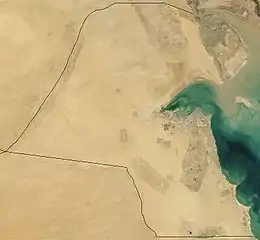Wildlife of Kuwait
The wildlife of Kuwait consists of the flora and fauna of Kuwait and their natural habitats. Kuwait is a small country in the Middle East at the head of the Persian Gulf, located between Iraq and Saudi Arabia, and the land surface consists mainly of desert.

Geography
Kuwait is 17,820 km2 (6,880 sq mi) in size, being about 200 km (124 mi) from north to south and 170 km (106 mi) from east to west. It has 195 km (121 mi) of coastline on the Persian Gulf and includes nine islands, the largest being Bubiyan Island. The main geographical feature is the large Kuwait Bay, which provides a natural harbour and on the shores of which Kuwait City is located.[1] The country has no mountains, rivers or lakes, but consists largely of undulating flat land with some low hills. It is divided into four zones; a desert plateau to the west; salt marshes, mud flats and saline depressions around Kuwait Bay; sand dunes to the east; and a desert plain occupying the bulk of the country.[2]
Kuwait has an arid climate. The summer is hot and dry and the precipitation, which averages less than 8 cm (3.1 in) falls mainly in the winter in the form of unpredictable showers and as thunderstorms in spring. Dust storms can occur at any time of year but are more common in spring and summer. Average daily temperatures in the summer are around 43 °C (109 °F) while in winter they are 13 °C (55 °F), and there can be night frosts.[2]
Flora
The harsh climate and low rainfall limit the range of plants that grow in Kuwait, although about four hundred species of wild plant have been recorded. Desert plants are typically coarse grasses and salt-tolerant shrubs which tend to be low growing and often spiny; one of the commonest shrubs is Rhanterium epapposum, known locally as arfaj, which is used for forage by camels and sheep. After rainfall, annual plants spring up from seeds which may have lain dormant for years. The flowers they produce are often blue or purple and as soon as the seed is set, the plants wither and die.[3] About two thirds of the plant species are annuals with smaller numbers of perennial plants, shrubs and sub-shrubs. The native flora is in transition between semi-desert and desert vegetation and is of importance in the study of how humans are impacting semi-desert habitats. The aftermath of the Gulf War and the inundation of much of the land with hydrocarbon residues has caused considerable damage to the soil structure and considerable changes to the environment.[4] Date palms have been planted at oases and near the coast and mangroves and sea grasses grow on the mudflats near Kuwait Bay, their roots helping to stabilise the coastline.[3]
Fauna

Some 429 species of bird have been recorded in Kuwait, some being resident, others being migratory and many others being rare or accidental.[5] The Mubarak Al-Kabeer Reserve Ramsar Site on Boubyan Island consists of lagoons and saltmarshes and is visited annually by wetland birds migrating from Eurasia to Africa, and others travelling from Turkey to India. Other birds live and breed on these wetlands all year round, including the world's largest breeding colony of crab-plovers.[6] Among the resident birds, the commonest is the desert lark, and inland the kestrel and short-toed snake eagle are to be seen hunting over the desert.[7]
Away from the coast the searing heat and absence of surface water means that animals need to have special adaptations and behaviours to survive. Kuwait has only one species of amphibian, the variable toad (Bufotes variabilis), and has about 38 species of reptile. These include the Arabian sand boa, the black desert cobra, the monitor lizard and a number of different spiny-tailed lizards (Uromastyx spp.). Many of these spend the heat of the day in burrows, emerging at night to feed. The frog-eyed gecko (Teratoscincus scincus) does this, burrowing as deep as 1.2 m (4 ft) below the surface among the dunes of the coastal plains, where it remains cool and humid.[8]
Around 28 species of mammals have been recorded in the country.[4] Terrestrial mammals include several small desert rodents, the desert hedgehog, the African wildcat, the Arabian sand cat, the caracal, the Indian grey mongoose, the striped hyena, the golden jackal, the fennec fox, the honey badger, the Saudi gazelle, the goitered gazelle, the Arabian oryx, the dromedary and two species of bat. The dugong has been recorded in Kuwaiti waters in the Persian Gulf, as well as the Bryde's whale, the pygmy blue whale, the humpback whale, the finless porpoise, the Indo-Pacific humpbacked dolphin and the Risso's dolphin.[9]
Scorpions and dung beetles abound, and in the wetlands and mudflats around Kuwait Bay and the islands there are crabs and mudskippers, numerous species of fish, waterfowl, gulls, flamingoes and dugongs.[7]
References
- Philip's (1994). Atlas of the World. Reed International. pp. 84–85. ISBN 0-540-05831-9.
- O'Shea, Maria; Spilling, Michael (2010). Kuwait. Marshall Cavendish. pp. 8–9. ISBN 978-0-7614-4479-4.
- DiPiazza, Francesca Davis (2006). Kuwait in Pictures. Twenty-First Century Books. pp. 14–16. ISBN 978-0-8225-6589-5.
- Kassim, Tarek A.; Barceló, Damià (2009). Environmental Consequences of War and Aftermath. Springer Science & Business Media. pp. 144–146. ISBN 978-3-540-87961-9.
- Lepage, Denis (2018). "Checklist of birds of Kuwait". Bird Checklists of the World. Avibase. Retrieved 29 January 2019.
- "Kuwait becomes Ramsar state". BirdGuides. 7 September 2015. Retrieved 29 January 2019.
- O'Shea, Maria; Spilling, Michael (2010). Kuwait. Marshall Cavendish. pp. 58–61. ISBN 978-0-7614-4479-4.
- Balliett, James Fargo (2014). Freshwater: Environmental Issues, Global Perspectives. Routledge. p. 68. ISBN 978-1-317-47015-1.
- The IUCN Red List of Threatened Species: Mammals of Kuwait. IUCN. 2001
